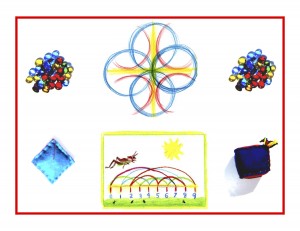Day 24
For one year, 365 days, this blog will address the Common Core Standards from the perspective of creating an alternate, ambient learning environment for math. Ambient is defined as “existing or present on all sides, an all-encompassing atmosphere.” And ambient music is defined as: “Quiet and relaxing with melodies that repeat many times.”
Why ambient? A math teaching style that’s whole and all encompassing, with themes that repeat many times through the years, is most likely to be effective and successful. Today’s blog will focus on the Kindergarten Common Core Math Standards and ambient counterparts that appeared in this blog on Days 4, 5, and 6. (Looks like I will be doing five groups of three posts, rather than three groups of five (too much good content to share). Note that the standards will be paraphrased and will appear in blue.
Day 4
Counting and Cardinality K.CC
Count to tell the number of objects.
4. Relationship of number to quantity: counting and cardinality.
a) Recognize the counting order of numbers, and that each named number is unique to its quantity.
b) The number of objects is the same regardless of their arrangement or order.
c) Each successive number name represents a quantity that’s one larger.
This activity uses jars and beans to show the uniqueness of each number up to 20 through the number of beans inside the jars, while demonstrating that the jars themselves can also be counted as objects, regardless of their bean/number contents. It would be a good idea to seal these jars so the contents can’t be changed. At the same time, a nice variation would be to have two small bins of the black and kidney beans along with empty jars available so the child(ren) can experiment with counting and filling the jars themselves. As with other activities brought to the Free Play time, this activity could be introduced and then made available in the Math Corner for free or gently guided play.
Day 5
Counting and Cardinality K.CC
Count to tell the number of objects.
5. Arranging up to 20 objects in a line, a rectangular array, or a circle, count how many. Do the same with up to 10 scattered objects.
The essence of each number is conveyed visually without getting too abstract by using stone counters. Each one can represent a number up to 10, and then used together with blank stones to determine the number of objects. Here’s how: take 5 blank stones and line them up next to the group of counting stones to 10. Ask which counting stone matches each blank stones’ configuration. (Yesterday’s number jars can be used for counting up to 20.) Have the children help gather the stones (flat ovals are best) and also be very present when you apply the dots, counting as you go. These materials can be stored in the Math Corner for free or gently guided play after they’re introduced. (Look for the other activities in this post in the Circle Time and Outside segments.)
Day 6
Counting and Cardinality K.CC
Compare numbers.
6. Know whether numbers in two groups are greater than, less than, or equal to one another.
7. Compare two numbers between 1 and 10 as written numbers.
Yesterday’s counting stones could be paired with natural counting objects like acorns, shells, glass beads, or small stones for the purpose of comparing and matching. The symbols for “greater and less than” could be introduced very pictorially as described in the Day 6 post. Go to the bottom of the Day 11 post to see how to introduce the equals or “is” sign. Follow the suggestions for the written portion, using the counting lines rather than numerals. For a fun alternative to pencil and paper, have the child(ren) write the numbers in a sand tray with a stick or pencil, or use a brush and water to write the numbers on a slate or other surface. Again all of these materials could be lovingly stored in the Math Corner for use after they’ve been introduced, for free or gently guided play.
Knowledge ensues in an environment dedicated to imaginative, creative knowing, where student and teacher alike surrender to the ensuing of that knowledge as a worthy goal. More Kindergarten tomorrow!












